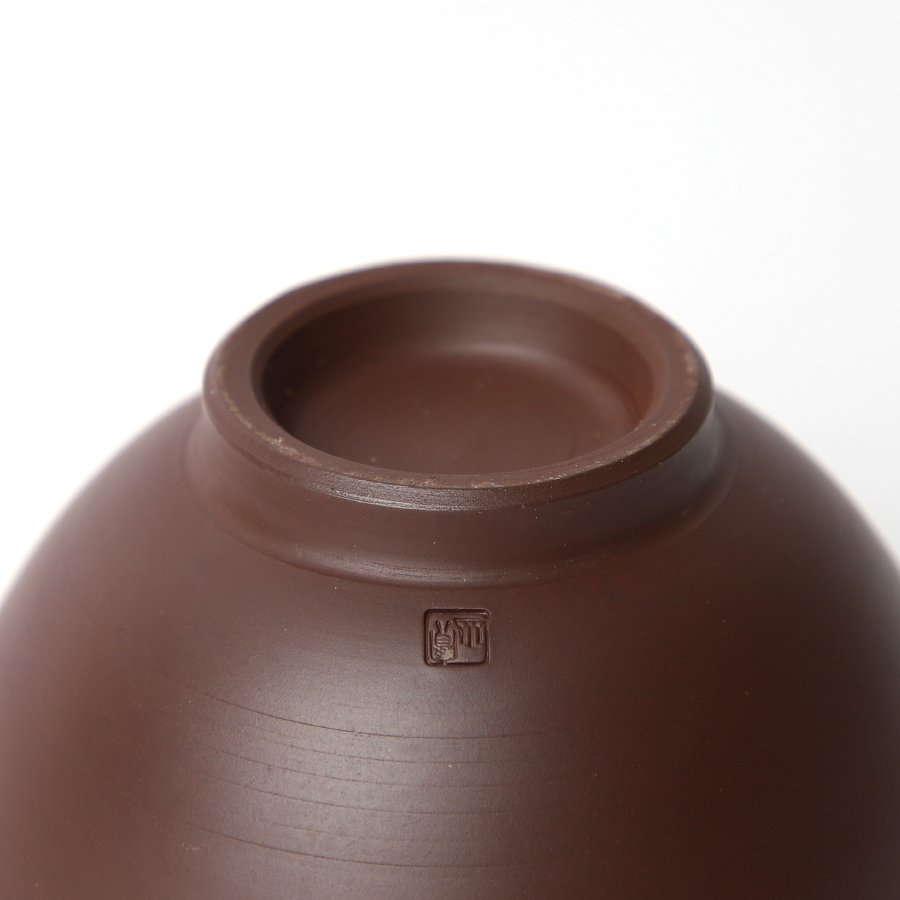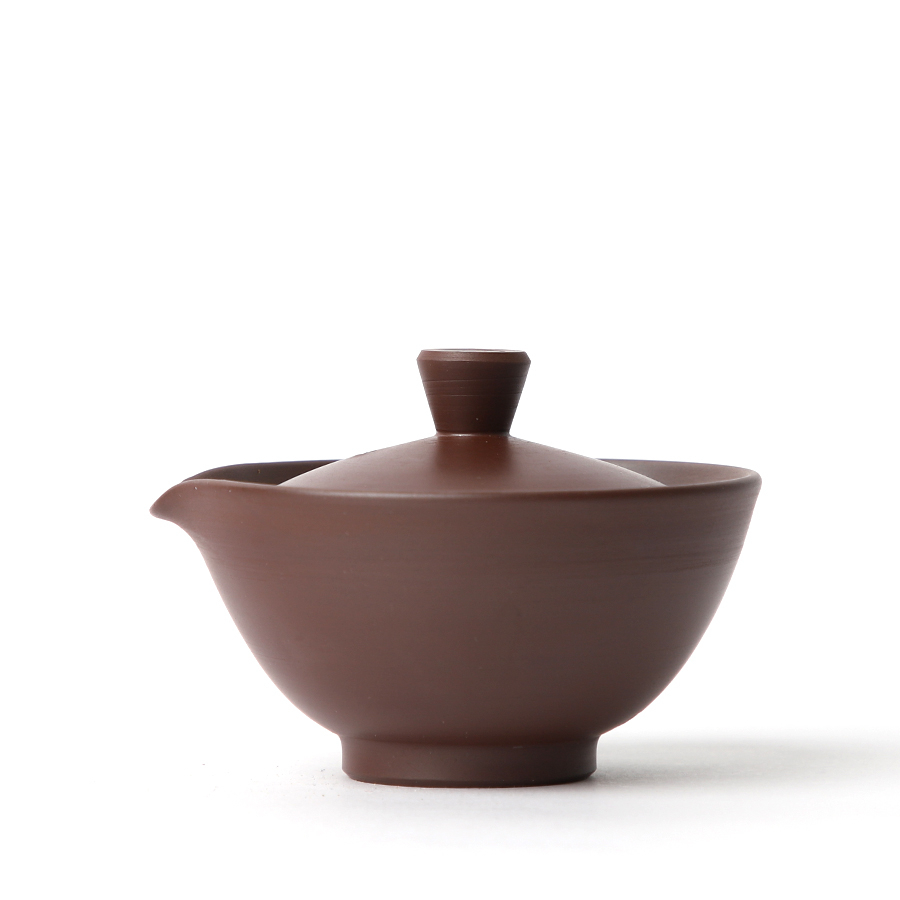Clay
Red, natural Banko clay
Rokuro
The components of lid and jug are hand-potted on the potter's wheel and then assembled to fit exactly (rokuro; 轆轤)
Glaze
Unglazed (yakishime; 焼き締め)
Choose your language:
Jitsuzan
Type |
Shiboridashi (絞り出し) |
|---|---|
| Kiln | Banko Yaki (萬古焼) |
| Studio/Artist | Meister Itō Jitsuzan (伊藤実山) |
| Origin | Yokkaichi, Mie Prefecture, Japan |
| Capacity | 120ml |
| Recommended fill line | For optimal serving, it is recommended to fill only up to the last third of the vessel |
| Dimensions | 9 x 5cm |
| Weight | 460g |
| Clay | Natural Banko clay |
| Glaze | Unglazed (yakishime; 焼き締め) |
| Production | The lid was ground to fit the body (Suriawase technique; すり合わせ), a sign of originality from Tokoname |
| Artist's Stamp | Yes |
| Packaging | Wooden box signed by the artist |

Born in 1937, Ito Jitsuzan is certified in traditional Japanese craftsmanship (伝統工芸士). He inherited the craft from his father and thus represents the second generation of Jitsuzan. He has won numerous awards, including the award for significant contribution to the intangible cultural heritage of Yokkaichi City. Ito Jitsuzan is also one of the few kyusu makers in Yokkaichi who still work with the traditional kata banko (型萬古) technique, in which the clay is applied thinly to wooden moulds and carefully separated after drying. Even though this method is very time-consuming and requires a lot of skills, Ito Jitsuzan feels that it conveys a delicacy that cannot be expressed on the potter's wheel.

A shiboridashi is a traditional Japanese teapot especially conceived for smaller quantities of high-quality Japanese green teas. The teapot is made out of fired natural clay and is unglazed on the inside. When brewing green tea, the body reacts and brings out certain aromas. The tea can steep by floating freely in the pot.
Throughout history, there have been hundreds of ceramic centres in Japan, wherever the volcanic soil had rich clay deposits. Some are still active today, including the six most important "old kilns" (Rokkoyo): Bizen, Shigaraki, Seto, Echizen, Tamba and Tokoname. But also others, such as Karatsu, Hagi, Mino, Shino, Oribe, Setoguro Ki-Seto and Kyo-yaki, and for tea ceramics especially Banko in Yokkaichi.
They differ regionally according to the composition of the clay, the prevalent firing method, the handwork steps, decoration and glazing techniques and the fineness or deliberate coarseness of the production. Above all, the clay and the firing determine the flavourful character of the shiboridashi, i.e. which types of flavours of a tea are lifted or subdued by it. Therefore, tea lovers often have various shiboridashi of different qualities at home to enable the optimal preparation depending on the tea and its quality. Among the finest and most valuable shiboridashi are those made by well known artists who are not only famous for their special talents in making, shaping and decorating, but also for their own production of natural clay as well as their own firing techniques resulting in unique qualities.
Led by the living national treasures, the most highly awarded masters, there is a whole hierarchy of craftsmanship, ranging from studios that still draw on the reputation of past masters, young and wild studios, to family-run micro-enterprises that produce the bulk of everyday ceramics. Important collector's items are the vintage shiboridashi, which are still made entirely from now exhausted deposits of the highest quality natural clay of the respective region and thus achieve incomparable qualities in tea infusion.

This comparatively younger but still highly prized pottery comes from Yokkaichi in Mie, Japan, where it is being produced since the 18th century. Occurrences of a clay similar to that used for Chinese Yixing ceramics (Zisha Clay) enabled the use of similar manufacturing techniques as in China and the emergence of one of Japan's most important ceramic centres.
The original clay was exclusively yellow (the same as in Yixing) and became brownish-purple when fired. This was due to a particularly high iron content of about 6-7%. It could be fired at higher temperatures, around 1200°C. With the drying up of the original Banko clay since about the 1990s, potters mostly mix red clay with yellow clay, which is sourced by studios from different regions. Only vintage kyusu have 100% original clay from Yokkaichi.
A key characteristic of Banko Yaki is the strong reduction firing. It removes the oxygen from the clay and results in greater hardness and porosity. It is also responsible for the famous brown/purple colour with a special, almost metallic sheen. Banko clay is also known for its special properties in terms of taste and effect on Japanese green tea.
Red, natural Banko clay
The components of lid and jug are hand-potted on the potter's wheel and then assembled to fit exactly (rokuro; 轆轤)
Unglazed (yakishime; 焼き締め)
A shiboridashi should first be warmed with warm water before the actual tea preparation, so that the clay can react better with the tea leaves. Only then, you can add the tea needles with a wooden spoon. Advanced and connoisseurs usually make the tea much stronger than beginners, who are less used to the intense taste and bitter substances.
Now pour the water carefully and slowly over the leaves, ideally from a yuzamashi (vessel for cooling the water after boiling) of the same or similar clay and fire. For best results, fill the water only to the top third of the shiboridashi strainer. During the brewing time, please close the lid.
To pour, hold the shiboridashi with one hand so that the thumb rests on the knob. Make sure that the small opening on the lid is level with the spout. Then pour the tea slowly into the cup in several puffs and drink it fresh. If several cups are being filled, they should be poured in small steps one after the other to achieve an even result for all cups. At the end of pouring, gently but firmly jerk the shiboridashi down repeatedly with both hands to extract the last, particularly rich drops from the tea.
Please always use low-limestone water for all preparation and cleaning steps of Japanese ceramics.
After the last infusion, please remove the tea from the shiboridashi and rinse it vigorously with water only. Do not scrape or use cleaning products. Finally, rinse the inside and outside of the pot with low-lime, soft water to prevent any detrimental limescale deposits. Briefly wipe the outside with a clean cloth. Then leave the shiboridashi open so it can dry completely. Once it is dry, it will be ready for the next infusion.


